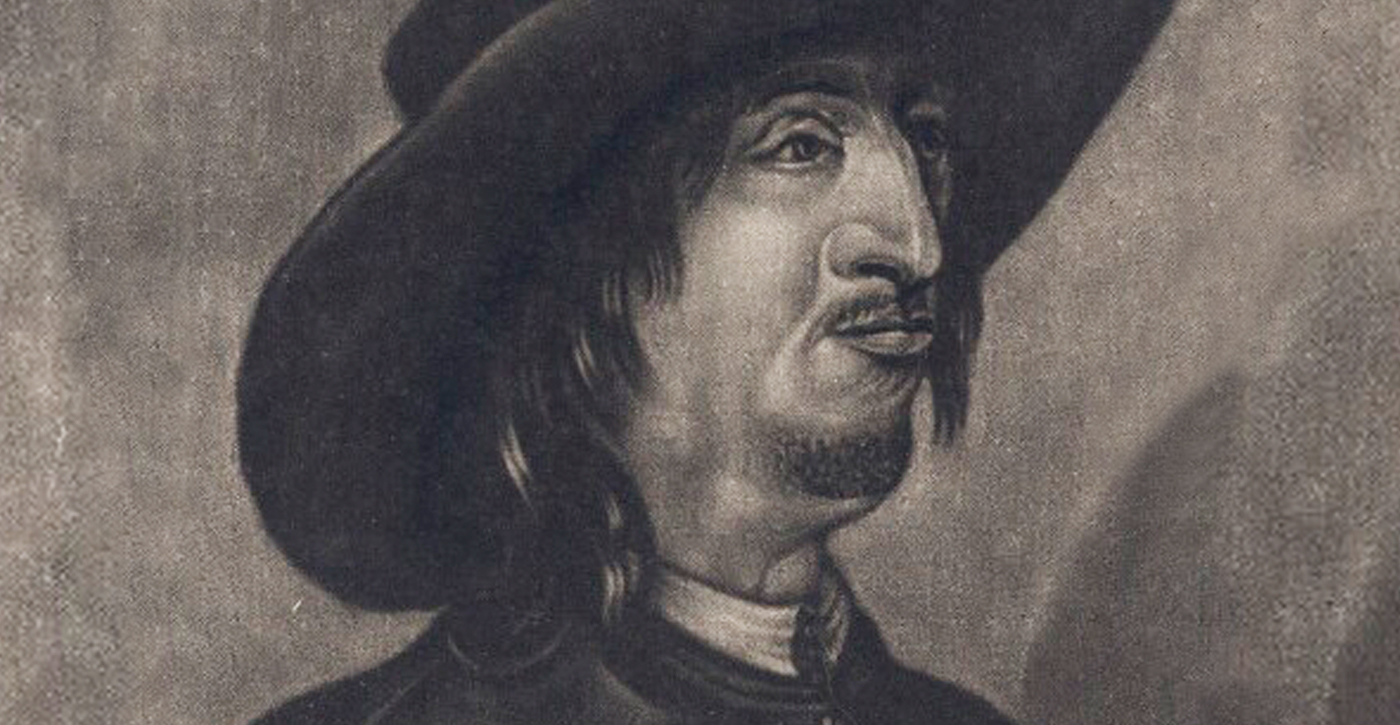The Vision of James Nayler
The doctrine of Atonement within the Christian tradition is an important but often controversial topic. There was a distinctive understanding of atonement in the earliest Quaker movement, which differed in a number of ways from the teachings of other Christian groups at the time. How is this peculiar vision described in the writings of James Nayler? He was, arguably, the most important and prolific Quaker apologist during the early 1650s.
In Western Christianity, the doctrine of Atonement has tended to focus almost exclusively on the death of Jesus as the essential basis of a reconciled relationship between God and humanity. Within Reformed Puritanism, which dominated the religious scene in seventeenth-century England, this death was conceived as a legal transaction in which Jesus accepted, on our behalf, the punishment demanded for human sin, if divine justice was to be done; this is often called “penal substitution.” As we shall see, James Nayler rejected both a narrow definition of atonement, and the centrality of a quid pro quo transaction. Because of the dominance of a crime-and-punishment framework in the West, “to atone” has come to mean reparation: to make amends for something. However, the etymological root of the word points to the reconciliation of a broken relationship, leading to a state of union: to be “at-one” with God. Some Friends regard such doctrinal matters as irrelevant “notions”; however, they cut to the very heart of the Christian faith. What was the purpose of the Incarnation of Jesus Christ? What did he achieve in his life, ministry, death, and resurrection? How do humans benefit from these divine actions?
In order to fully appreciate the early Quaker conception of atonement, it is necessary to place it within its religious context. What exactly was Nayler responding to in his writings? We have already noted that Reformed Puritans understood Jesus’s death as penal substitution: a legal transaction or punishment received in our place. It is also important to take account of five other essential features of Reformed Puritan belief. Firstly, there is divine sovereignty, meaning that God is in control and unaffected by human actions. Secondly, there is the total depravity of humanity, who are spiritually dead and incapable of doing anything pleasing to God. Thirdly, there is monergism, which implies that salvation is God’s work alone with no human involvement other than having faith in God’s promises (as opposed to synergism, where humans cooperate with God in the salvation process). Fourthly, there is predestination and limited atonement, meaning only “the elect” will be saved, and God has determined this from the beginning of time. Finally, the faithful (the elect) become acceptable to God by imputed righteousness. The righteousness of Christ is merely credited to them, rather than given to them.
Christ was not merely a figure from history who had taken the punishment for human sin, he was a real, living presence available to all people. This is the religious framework within which Nayler’s vision of atonement takes shape.
James Nayler’s religious thought can be regarded as an expression of a radical form of Puritanism, emerging in England in the years leading up to the English Civil Wars, which distinguished itself in a number of important ways from mainstream Puritanism. Based on their own spiritual experiences, radical Puritans tended to reject predestination; imputed righteousness; and the limited, transactional view of atonement. They declared that the power of the Holy Spirit had been poured out upon them, liberating them from sin, and enabling them to reveal the divine nature in their lives. At the same time, they claimed to be the true heirs of the Reformed tradition, upholding the principles of divine sovereignty, total depravity, and salvation by faith and the work of God alone. Drawing inspiration from the radical wing of the European Reformation, they emphasized a spirituality of human surrender and passivity, and the experience of both divine intimacy and real transformation in this life. Christ was not merely a figure from history who had taken the punishment for human sin, he was a real, living presence available to all people. This is the religious framework within which Nayler’s vision of atonement takes shape.
For him, there were two distinct but interconnected aspects of the atoning work of Christ: (1) his physical actions within the world during the Incarnation, and (2) his transformative actions within his people through a second coming in Spirit. In the Fall, humans had turned away from God’s love and wisdom to focus instead on their own limited and deluded imaginations and perceptions. As a consequence, their lives became dependent on created things, rather than on the Creator, and this led to pride, greed, violence, injustice, and destructiveness. Hence, it is not God who needs to be reconciled with humans, but rather it is humans who need to be reconciled with God. Salvation involves being reconnected with divine love and wisdom, leading to a life of humility, generosity, peace, justice, and harmony. The coming of Christ in the flesh in the Incarnation was a divine intervention into the earthly existence of humanity. God was reaching out to people, seeking to be reunited with them in Christ. Humans are, in a sense, a microcosm of the whole creation, and so, when they are reconciled and healed, so is the rest of the physical world. How exactly did Christ do all this in an objective way in his Incarnation? Nayler suggests that his life in the flesh led to four essential achievements:
- He created a new humanity, fully in God’s will, likeness, and image.
- He established a new covenant relationship between God and humanity that was direct, inward, intimate, and transformational in nature.
- He expanded the definition of God’s chosen people to include all those living in the new humanity and the new covenant.
- He inaugurated a new creation where God is all, and in all, through divine rule.
He achieved these things through his role as victim, illuminator, and victor. He established himself as the eternal divine priest, sacrifice, reconciler, physician, teacher, judge, law-giver, conqueror, liberator, and ruler.
The faith and practice Nayler and other early Friends accepted was that humans were incapable of contributing to their own salvation, that this was God’s work alone, but it was freely offered to everyone through the Holy Spirit.
Because of their emphasis on the subjective work of Christ in Spirit within his people, early Friends were often accused of neglecting the objective work of Christ in the flesh. However, Nayler is very clear that had Christ not first achieved these things in his outward life, it would not have been possible for people to experience the new life in Christ by the work of the Holy Spirit within them. What Christ had inaugurated in the Incarnation would not be fully realized until it was fulfilled within people. It is this that establishes the new creation. He describes coming to this understanding in his own experience:
And though the foundation of this faith or beginning of it was, that I did really believe in that which Christ did and suffered at Jerusalem . . . and much more might be said of him there finished, all which I did believe according to Scripture, which was as an opening of me to receive him from heaven in the same Spirit and power without which I could not have received the gift of that holy Spirit, God having so purposed from the beginning, that the covenant of eternal life and power should be received no other way but by faith in him. . . . (The Works of James Nayler [WJN 4:73])
Hence, in the new covenant, people enter into the renewed humanity established by Christ through an inward and spiritual participation in the Incarnation event. By the work of the Holy Spirit, Christ is born within us, teaches us, heals us, performs miracles within us, dies, and is resurrected within us. Christ “is the election, and the elect seed in whom the election is obtained, and in whom alone it is established” (WJN 3:94). In his role as divine sacrifice, we come to know Christ as our inward priest and offering, reconciling us with God, and healing our corrupted will. He is the one in whom God and humanity meet, and he has been poured out on all flesh. The blood of Christ is “a living substance, which is to be known, with its effect, to every particular saint in every generation” (WJN 3:244). In his role as illuminator, we come to know Christ as our inward teacher, judge, and law-giver. He shows us our darkness and leads us to new life, writes God’s law on our hearts, and teaches his people himself (Jer. 31:33-34 / Heb. 8:10-11). Christ is the “true teacher, whereby all shall be taught of God” (WJN 1:43). In his role as victor, we come to know Christ as our inward conqueror, liberator, and ruler. He defeats the evil within us, liberates us from spiritual bondage, and becomes the power that rules within us. Christ “rules in righteousness in the hearts of his people” (WJN 3:128). He does this, “to restore all things, and make all things new, as they were in the beginning, that God alone may rule in his own work” (WJN 4:2). The fruit of this inward work is an outward life that reveals the perfection of the divine nature, so that “it is no longer I who live, but it is Christ who lives in me” (Gal. 2:20). Nayler describes this participation in Christ as follows:
that which is born of the heavenly, is heavenly, spiritual, eternal, and incorruptible; which is the state of the new man, which of God is begotten of the divine nature; and as is his nature, so is his works; and so his delights are spiritual; for as is the man, so are his works; and as is the tree, so is its fruit. And so he that is born of this seed is born of God; and he that is born of God sins not, in whom that seed remains (WJN 3:97).
The faith and practice Nayler and other early Friends accepted was that humans were incapable of contributing to their own salvation, that this was God’s work alone, but it was freely offered to everyone through the Holy Spirit. These convictions are reflected in the Quaker practice of unprogrammed, expectant waiting worship, in which people stop, become still, and make themselves available to God. This is a spirituality of passivity and surrender which recognizes both divine sovereignty, and the human tendency to ignore or resist God’s saving works. Within medieval mystical piety and the spirituality of radical Reformation groups, such as the Anabaptists, this is often called gelassenheit, a practice of yielding ourselves to God’s will. Hence, Nayler encourages people to:
give all diligence to the Spirit’s motion and leadings, what it moves against, and what it leads to; for now will God make all things new: a new creation, new heavens, and new earth, and new heart and mind, and a new law (WJN 4:160).
This vision seems to closely reflect the early Church doctrine of Recapitulation. In this understanding of atonement, the ultimate goal of the work of Christ is to show solidarity with humanity, and to offer us his divine life. A frequent proclamation of the early Church was that Jesus Christ became what we are, to enable us to become what he is. Therefore, the Incarnation is viewed as a divine in-breaking into history to reverse the Fall and transform humanity. In the Cross, Christ overcomes human rebellion, and heals us through his own obedience. This is a kind of substitution, because he does something for us that we could not do for ourselves. What humans lost in Adam, they recover in Christ. So, the work of Christ restores humanity by reconciling the broken relationship with God, perfects humanity by restoring the image and likeness of God, and achieves victory and liberation by defeating evil and releasing humanity from bondage.
This is best understood as an outrageously generous gift offered by God to the whole of humanity, rather than as a legal transaction based on debt and repayment, or crime and punishment.
James Nayler’s conception of atonement as the work of Christ takes account of both its objective impact (how it changes things generally) and its subjective implications (the influence it has on individual humans). It incorporates the entire Incarnation event, and draws on the many and varied images and metaphors found in the New Testament. His understanding is participatory and therapeutic in nature, meaning that it involves a genuine inward sharing in the life of Christ in Spirit (participation) and a fundamental change in the human condition (therapeutic). His focus is on the way in which the Incarnation has made it possible for humans to be healed and transformed by divine indwelling. The Fall, with all its negative implications for the human condition and the well-being of the creation, is reversed. We are now able to participate in the work of Christ as a real inward and spiritual experience. In this way, deep within us, we can now meet God, who delights to walk in us, as in a garden:
and sinking down into this meekness and steadfast lowliness, you will come to feel the plant of God that brings forth this meekness and holiness, and springs of living virtue; and there will you meet the Lord in his kingdom on earth, where he delights to walk as in a garden (WJN 4:147)
The idea that people primarily benefit from the atoning work of Christ through the outward sacraments and liturgies of the Church (the Catholic position) or by faith alone in God’s promises (the Reformed position) is rejected. It seems that, for Nayler, what the entire sacramental system of the Church pointed to had to be experienced in its real substance, as an inward and spiritual participation in the life and work of Christ. Therefore, this is best understood as an outrageously generous gift offered by God to the whole of humanity, rather than as a legal transaction based on debt and repayment, or crime and punishment. In this sense, the early Quaker conception of atonement reflects a distinct, if marginal, stream of Western Christianity that had its roots in the radical wing of the Reformation and in dissenting tendencies within English Puritanism.





Comments on Friendsjournal.org may be used in the Forum of the print magazine and may be edited for length and clarity.